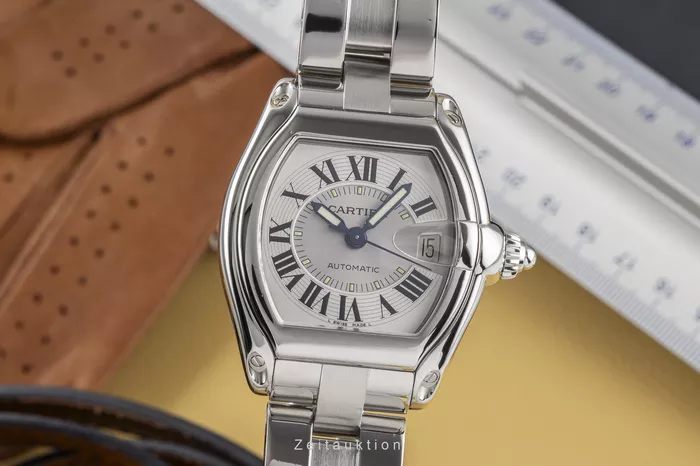The Cartier Santos collection is one of the most iconic and enduring lines in the luxury watch industry. Since its inception, it has represented a perfect blend of elegance, innovation, and historical significance. This article will delve into the specifics of Cartier Santos watches, focusing particularly on whether they are automatic.
History of the Cartier Santos Collection
Origins and Legacy
Early Beginnings: The Cartier Santos was introduced in 1904 by Louis Cartier. It was designed specifically for aviation pioneer Alberto Santos-Dumont. This makes it one of the first wristwatches created for practical use in aviation.
Design Innovation: The original design featured a square case, which was revolutionary compared to the traditional round watches of that era. This design has remained a defining characteristic of the Santos collection.
Evolution: Over the years, Cartier has updated the Santos to incorporate modern watchmaking techniques while retaining its classic charm.
Key Features of Cartier Santos Watches
Design and Aesthetics
Case Shape: The Santos is known for its distinctive square case with rounded corners. This unique shape sets it apart from other luxury watches.
Materials: The collection is available in various materials, including stainless steel, gold, and platinum. Cartier also offers versions with diamond embellishments.
Dial and Hands: The dials typically feature Roman numerals, a signature element of Cartier’s design, and blue sword-shaped hands.
Movement Types
Cartier Santos watches can be classified into different categories based on their movements. Here’s a detailed look at whether they are automatic:
Cartier Santos Automatic Movements
Automatic vs. Quartz
Automatic Watches: These watches are powered by the movement of the wearer’s wrist, which winds the mainspring. They do not require a battery and are highly valued for their craftsmanship.
Quartz Watches: These use a battery and quartz crystal to keep time. They are known for their accuracy and low maintenance.
Automatic Movements in the Santos Collection
Santos-Dumont: The Santos-Dumont collection, particularly the models from the early 20th century, primarily features manual movements. However, recent releases may include automatic variants.
Santos 100: This modern iteration of the Santos collection features automatic movements. Cartier uses its in-house automatic calibers, such as the Caliber 1847 MC, in these models.
Santos de Cartier: The newer Santos de Cartier models also come with automatic movements, reflecting Cartier’s commitment to blending tradition with modern technology.
Popular Automatic Models
Santos de Cartier Large Model: This model features an automatic movement and is available in various materials, including steel and gold.
Santos de Cartier Chronograph: This model combines automatic movement with chronograph functionality, adding a sporty element to the classic design.
See Also: How Much Is A Cartier Tank Watch Worth
How to Identify an Automatic Santos Watch
Case Back Inspection
Transparent Case Back: Many automatic Santos watches have a transparent case back that allows you to view the movement inside. This is a clear indicator that the watch is automatic.
Movement Markings: Look for markings or engravings on the case back that indicate the movement type. Cartier often includes details about the movement on the back of the watch.
Watch Specifications
Model Information: Check the specifications of the specific Santos model. Cartier provides detailed information about the movement type in their official documentation and on their website.
Retailer Information: Authorized Cartier retailers can provide information about the movement type for specific models.
Benefits of Automatic Movements
Advantages Over Quartz
Craftsmanship: Automatic movements are often seen as a testament to the watchmaker’s art and craftsmanship.
Longevity: With proper care, automatic movements can last for decades or even generations.
No Battery: They do not require battery changes, making them more environmentally friendly.
Drawbacks
Accuracy: While automatic movements are precise, they may not match the accuracy of quartz movements.
Maintenance: They require regular servicing to maintain their accuracy and functionality.
Cartier’s Commitment to Innovation
Technological Advancements
In-House Movements: Cartier has invested in developing its own movements, ensuring high quality and reliability.
Design Evolution: Cartier continues to innovate in terms of design while respecting the heritage of the Santos collection.
Future of the Santos Collection
New Releases: Cartier frequently updates the Santos collection with new models that feature advanced movements and updated designs.
Collector’s Appeal: The Santos collection remains a favorite among collectors due to its rich history and timeless design.
Conclusion
Cartier Santos watches are available with both automatic and quartz movements. The choice between them depends on individual preferences and the specific model. The automatic versions, such as those in the Santos 100 and Santos de Cartier collections, highlight Cartier’s dedication to blending historical elegance with modern technology. Whether you are a watch enthusiast or a new collector, the Cartier Santos collection offers a range of options to suit your taste and needs.

